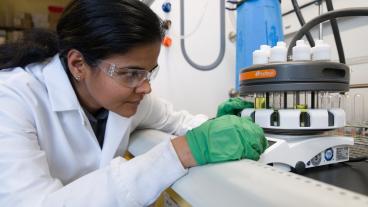Mines researchers contribute to creation of world’s first quantum magnet in one dimension
Physics Assistant Professor Zhexuan Gong led group of theoretical physicists who collaborated with experimental physicists on the effort recently published in Nature

While magnets are common in our three-dimensional (3D) world, discovering them in one- or two-dimensional materials has long posed a challenge to scientists.
A 2D material is a very thin film with a thickness of a single atom, such as graphene, while a 1D material is just a chain of atoms. These low-dimensional materials have become increasingly attractive for a wide range of applications from electronics and energy storage to catalysis and quantum computing.
In a paper recently published in the journal Nature, a team of physicists from Colorado School of Mines, Duke University, Michigan State University, and the University of Maryland realized the dream of building a 1D magnet using a trapped-ion quantum simulator.
While the magnet is tiny – consisting of only 23 atoms – it shows robust magnetic properties that are expected to survive as more atoms are added. The work is the result of a successful collaboration between a group of theoretical physicists led Zhexuan Gong, Assistant Professor of Physics at Mines, and a group of experimental physicists led by Christopher Monroe, Professor at Duke University.

“The fact that a magnet has a specific orientation defined by its north and south poles is interesting by itself. When a magnet is forming, why does it pick that direction instead of any other direction? The answer to this question lies in a phenomenon called spontaneous symmetry breaking, which is essential in how nature creates the world we live in,” said Casey Haack, a Mines PhD candidate in Gong’s group and the first theory author of the paper. “Our work demonstrates spontaneous symmetry breaking in a way that has never been observed before.”
In recent years, scientists have made progress in making 2D magnetic materials. A notable example is the so-called magnetic graphene. However, no 1D magnetic material was known to exist. In fact, physicists have proven that magnets cannot exist in 1D at any nonzero temperature so long as the electrons only interact with their nearby neighbors, which appears to be the case for most materials in nature.
However, this “no-go” theorem did not rule out 1D magnets when the electrons can interact with each other over a sufficiently long range. To realize such long-range interactions, the research team used a device called quantum simulator, which can assemble a tiny piece of material atom by atom, controlling the interactions among the atoms or electrons precisely.
One such quantum simulator is made by trapping a chain of ions, or charged atoms, using electric fields and engineering the interactions among the ions using lasers. These trapped ions are also useful for a number of rapidly growing quantum technologies such as quantum computing and quantum metrology.
“My colleagues and I proposed the idea of building a 1D magnet that survives at a finite temperature using trapped ions several years ago. The idea was challenging to implement at the time, and I am very excited that the experimentalists actually managed to demonstrate the idea with our help,” Gong said. “This work also reveals the endless possibilities a quantum simulator can bring for scientific discoveries. We can create lots of synthetic quantum materials that cannot be found in nature and harness the knowledge we gained from them for applications in either material science or quantum technology.”




